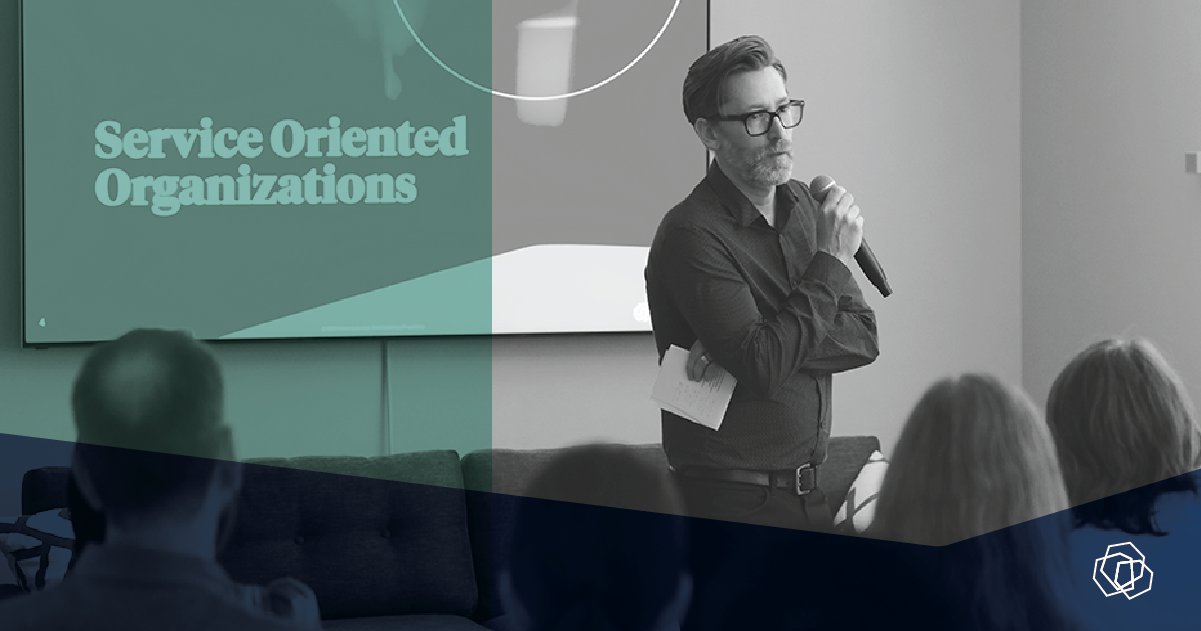
I had the pleasure of speaking at Harmonic’s Business Forum event during our 2023 Practice Week. My role was to set the table for my fellow speakers, who shared their insights and experiences of using service design techniques to increase organizational collaboration to solve complex business problems. My brief talk focused on the importance of creating a culture of service orientation to create greater value for all service participants. What follows are my prepared remarks as presented at the event.
Thank you, everyone, again for joining us this evening. And thank you to our speakers. Each of you has brought so much to the service design profession and the organizations you have worked with, and I can’t wait to learn from you this evening. I’m going to do my best to do a little table setting for you and then get out of the way.
It was interesting to hear why you attended tonight’s event. The challenges you noted reflect what I hear from leaders across industries and functions within organizations. Not enough focus on customer needs. Fragmented customer experiences. Agility efforts that lead to more outputs but fail to achieve strategic outcomes. A lack of time and effort to address systemic challenges.
And I have heard the same desires. Being customer-centric, not just saying it. Making experience material to strategic decisions on what we create, reimagine, or improve. Shifting to operating models that place emphasis on differentiated end-to-end experiences, not disconnected products and features. Creating more space for strategy and architecture to help create sustainable and more impactful outcomes.
Tonight, you will hear some leaps forward and setbacks in attempting to achieve these aims. It is hard work. But it is the right work to help create better business outcomes while doing the same for customers, employees, and every person participating in or impacted by our service economy.
“Service” is a word you will hear often tonight. Organizations strive to bring together a unique set of capabilities to help people do something meaningful and receive more value than the effort they put in. We should remember that these services are made possible by many people who also deserve good experiences and value in their participation, whether coding a self-service touchpoint or being face to face with a customer creating. And we must remember that services impact more than the customer and service provider; they can impact many other people and the world around us.
We all are in one way, in service to one another. When we come together in organizations, the ideal is that we combine our talents to help people — our customers — to receive our collective service. And, in the process, we thrive as individuals.
But organizations are complicated, people are messy, and the world is complex. It’s easy to become internally focused; for attention and effort to shift towards how we’re organized, who has the power, who has the funding, who has the resources, and who doesn’t. And as organizations grow and, in today’s world, their interactions with people become increasingly mediated through digital technologies, the risk is drifting away from intentional service to impressing upon customers what we need them to do, NOT what they need from us.
For this reason, I prefer service orientation to customer-centricity as the critical transformation organizations must make. Service orientation is a mindset and set of practices that keep the needs of people and how we intentionally respond to them at the heart of the organization. Externally, this means providing services that both anticipate and respond to customers’ functional, emotional, and social needs AND creating a healthy exchange of value between the customer and service provider. Both win.
Internally, this means creating an environment where employees are highly attuned and empowered to address customers’ needs but also in how they help their employees have a great day at work and thrive. Everyone wins.
Service orientation requires a focus on outcomes, not outputs. It requires a shift in the architecture of an organization from functions to systems of experiential value creation, including service ecosystems and journeys. And it means creating the space for more intentional participation amongst employees and partners to work towards shared outcomes.
An organization is like a garden. Organizations with a service orientation work collectively to plan out the garden with intention, planting seeds and nurturing crops with a vision for how the fruits of that labor will produce not just crops, but a combination of ingredients that will make desirable dishes for customers. Service-oriented organizations also understand that the crops—the goods and services—are part of a more complex system, including the soil—the organization’s culture and ways of working—that they are planted in. This system is what service design helps address through defining better strategies, implementing people-centered architectures, designing organizations for psychological safety and creativity, and guiding intentional service activation and performance.
As you listen to the speakers tonight, you will walk away with the strategic value of service design in responding to the complexity of our world and the organizations that we work in. You will hear some practical approaches that can make an immediate impact by creating greater alignment on challenges that don’t fit neatly in one or two areas of ownership, by identifying small experiments to move quickly and build momentum, and by laying the groundwork to shift an organization’s orientation from product to service.